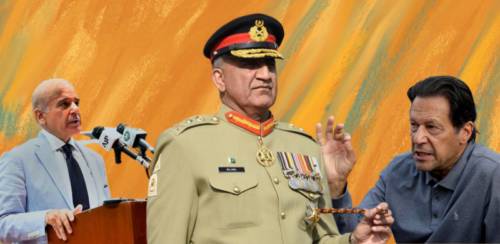
The last two weeks have been a political rollercoaster. From sedition, to attacks on the judiciary, to the rupee’s continuing teetering, things are shaping up to be uglier. How did we even get here?
Hybrid regimes, pet projects and their fallouts
Most people think the hybrid regime project was realised in 2018 when Imran Khan came to power. A hybrid regime, however, took root way before following curtains for General Musharraf. Both, the PPP and the PML-N governments colluded with the military through backhand deals to ensure stints in power. Even though it was thought that with Musharraf, the military too had exited, the truth was markedly different. To put it in Scooby Doo vernacular, every prime minister since 2008 was prevented from 'getting away with it' — complete a five- year tenure — because of 'those meddling kids'.

Imran accession to power in 2018 carried different baggage than any subsequent PPP or PML-N stints. It was a widely accepted fact amongst the more critical that the PTI was the military’s pet project, brought in to counter the narratives put forth by the PPP and the PML-N.
For a while, things were enviable until they weren’t. In 2021, the first public standoff between the military and Imran came to light. After a tussle over the appointment of a new ISI chief, it was clear that all was not well.
There were other indicators too. In September 2020, the four-party Pakistan Democratic Movement (PDM) was constituted. Many speculated this alliance couldn’t have been allowed to mobilise without a nod of approval from the powers that be with some positing this was the beginning of the end for Imran. The PDM accused the PTI government of poor governance, political victimisation, mismanaging both: the economy and foreign policy.
In, Out and Vote ko Izzat do
In 2022, Imran Khan was officially voted out through a vote-of-no-confidence in the National Assembly, the first ever successful one to take place in the country. While his ouster came through democratic practice, whispers again suggested that the only way the PDM could have pulled this off was if they had military backing, a claim Imran Khan had also been making in addition to accusing the United States of sponsoring ‘regime-change’.
Following Imran Khan’s ouster, PML-N leader Shehbaz Sharif was elected prime minister and the tables turned. Now, the very PML-N that had spent significant time rallying for civilian supremacy was supporting the armed forces and condemning Imran for his attacks on the military. Imran, for his part, was getting more aggressive and brazen with every next rally. He started from thinly veiled references and analogies to full blown accusations of corruption and lack of patriotism.
An Unending Barrage Of Attacks
On May 8, nearly a month after his ouster, Imran took a jab at the military leadership and aired a spate of opinions on the establishment. Presenting tales of Sirajud Daulah and Mir Jaffar, he compared his government to that of Daulah’s leading some to suspect him likening Chief of Army Staff General Qamar Bajwa to Mir Jaffar. Months-long back-and-forth Imran-Army jabs followed with Shehbaz stepping in to defend the military.
The attacks continued, new vernacular entered the discourse, people began to talk about the Mir Jafars and Sadiqs, those neutral and the imported. Around August, transmissions of ARY News —which had been accused of a pro-PTI orientation began to get blocked across various parts of the country.
On August 9, Imran’s chief of staff Shahbaz Gill was arrested for making remarks that were deemed ‘seditionary’ on ARY the night before. He had claimed that the government was trying to provoke the lower and middle tier of the army against the PTI, saying the families of such "rank and file" support Imran and his party "which is fueling rage within the government".
Imran further fanned flames on August 19 when he attacked the judiciary by threatening a woman judge who had heard Shahbaz Gill’s case. ““We will not spare the IG and DIG […] Judge Zeba Chaudhry should also prepare herself as a case will be registered against her,” he had said. Following his attack on the judiciary, PEMRA on August 21 slapped a ban on the live telecast of Imran’s speeches. The PTI then began telecasting them live on YouTube.
Most recently, on September 4, during a Faisalabad show of power, Imran called out Asif Ali Zardari and Nawaz Sharif for obstructing general elections so that they could appoint an army chief of their choice. Such an individual, he said, would not hold the two accountable. This statement stoked a massive backlash with politicians affiliated with the coalition government running to defend the military and censuring Imran.
Democracy, wherefore art thou?
Ahead of the PTI'S September 6 Peshawar gathering, the government authorised the Pakistan Telecommunication Authority to temporarily ban YouTube in the country. Today, on September 7, we are left with only questions and half-baked guesses as to how long this can go on.
Hybrid regimes, pet projects and their fallouts
Most people think the hybrid regime project was realised in 2018 when Imran Khan came to power. A hybrid regime, however, took root way before following curtains for General Musharraf. Both, the PPP and the PML-N governments colluded with the military through backhand deals to ensure stints in power. Even though it was thought that with Musharraf, the military too had exited, the truth was markedly different. To put it in Scooby Doo vernacular, every prime minister since 2008 was prevented from 'getting away with it' — complete a five- year tenure — because of 'those meddling kids'.

Imran accession to power in 2018 carried different baggage than any subsequent PPP or PML-N stints. It was a widely accepted fact amongst the more critical that the PTI was the military’s pet project, brought in to counter the narratives put forth by the PPP and the PML-N.
For a while, things were enviable until they weren’t. In 2021, the first public standoff between the military and Imran came to light. After a tussle over the appointment of a new ISI chief, it was clear that all was not well.
There were other indicators too. In September 2020, the four-party Pakistan Democratic Movement (PDM) was constituted. Many speculated this alliance couldn’t have been allowed to mobilise without a nod of approval from the powers that be with some positing this was the beginning of the end for Imran. The PDM accused the PTI government of poor governance, political victimisation, mismanaging both: the economy and foreign policy.
In, Out and Vote ko Izzat do
In 2022, Imran Khan was officially voted out through a vote-of-no-confidence in the National Assembly, the first ever successful one to take place in the country. While his ouster came through democratic practice, whispers again suggested that the only way the PDM could have pulled this off was if they had military backing, a claim Imran Khan had also been making in addition to accusing the United States of sponsoring ‘regime-change’.
Following Imran Khan’s ouster, PML-N leader Shehbaz Sharif was elected prime minister and the tables turned. Now, the very PML-N that had spent significant time rallying for civilian supremacy was supporting the armed forces and condemning Imran for his attacks on the military. Imran, for his part, was getting more aggressive and brazen with every next rally. He started from thinly veiled references and analogies to full blown accusations of corruption and lack of patriotism.
An Unending Barrage Of Attacks
On May 8, nearly a month after his ouster, Imran took a jab at the military leadership and aired a spate of opinions on the establishment. Presenting tales of Sirajud Daulah and Mir Jaffar, he compared his government to that of Daulah’s leading some to suspect him likening Chief of Army Staff General Qamar Bajwa to Mir Jaffar. Months-long back-and-forth Imran-Army jabs followed with Shehbaz stepping in to defend the military.
The attacks continued, new vernacular entered the discourse, people began to talk about the Mir Jafars and Sadiqs, those neutral and the imported. Around August, transmissions of ARY News —which had been accused of a pro-PTI orientation began to get blocked across various parts of the country.
On August 9, Imran’s chief of staff Shahbaz Gill was arrested for making remarks that were deemed ‘seditionary’ on ARY the night before. He had claimed that the government was trying to provoke the lower and middle tier of the army against the PTI, saying the families of such "rank and file" support Imran and his party "which is fueling rage within the government".
Imran further fanned flames on August 19 when he attacked the judiciary by threatening a woman judge who had heard Shahbaz Gill’s case. ““We will not spare the IG and DIG […] Judge Zeba Chaudhry should also prepare herself as a case will be registered against her,” he had said. Following his attack on the judiciary, PEMRA on August 21 slapped a ban on the live telecast of Imran’s speeches. The PTI then began telecasting them live on YouTube.
Most recently, on September 4, during a Faisalabad show of power, Imran called out Asif Ali Zardari and Nawaz Sharif for obstructing general elections so that they could appoint an army chief of their choice. Such an individual, he said, would not hold the two accountable. This statement stoked a massive backlash with politicians affiliated with the coalition government running to defend the military and censuring Imran.
Democracy, wherefore art thou?
Ahead of the PTI'S September 6 Peshawar gathering, the government authorised the Pakistan Telecommunication Authority to temporarily ban YouTube in the country. Today, on September 7, we are left with only questions and half-baked guesses as to how long this can go on.

